#large magellanic cloud
Explore tagged Tumblr posts
Text
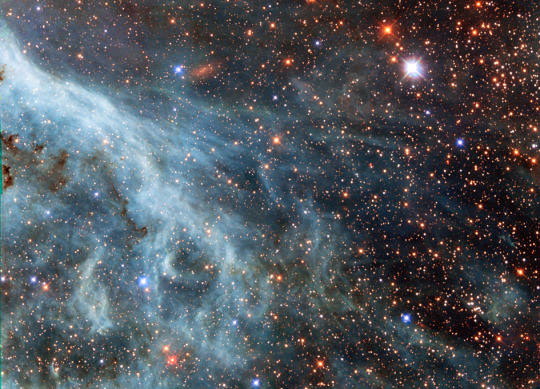

Within the LMC Galaxy
4K notes
·
View notes
Text

Cloudscape in Large Magellanic Cloud ©
#hubble telescope#space#astrophotography#stars#galaxy#universe#cosmos#nasa#planet#solar system#astronomy#night sky#nebula#large magellanic cloud
831 notes
·
View notes
Photo
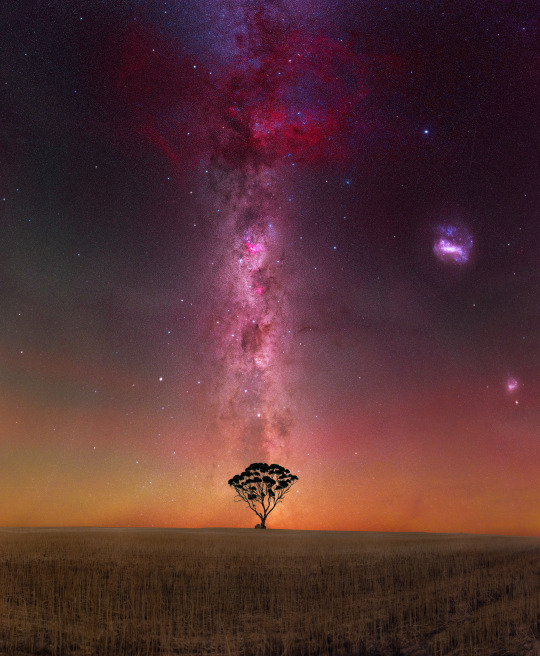
Milky Way at York, Western Australia
Nikon d810a - 50mm - ISO 6400 - f/2.5 - Foreground: 7 x 30 seconds - Sky: 35 x 30 seconds - iOptron SkyTracker - Hoya Red Intensifier filter
#Milky Way#stars#space#night#sky#Astronomy#astrophotography#landscape astrophotography#galaxy#universe#Crux#Carina#eta carinae#nebula#Magellanic Clouds#large magellanic cloud#small magellanic cloud#lone tree#gum#farm#Wheatbelt#York#Western Australia#outback
7K notes
·
View notes
Photo

Two galaxies suspended over an aurora by u/ThatAstroGuyNZ via r/Stargazing
#galaxies#astrophotography#aurora#aurora australis#night#sky#skyporn#space#night sky#stargazing#thatastroguynz#u/thatastroguynz#r/stargazing#reddit#photographers on reddit#stars#astronomy#photography#landscape#seascape#elements#nature#beauty#aesthetic#nz#new zealand#large magellanic cloud#small magellanic cloud#lmc#smc
93 notes
·
View notes
Text

Countless stars in the Large Magellanic Cloud, a satellite galaxy of the Milky way. James Webb Space Telescope
#james webb space telescope#james webb images#stars#astronomy#cosmos#nasa#large magellanic cloud#space images
30 notes
·
View notes
Text

Hubble witnessed a dwarf galaxy crashing through the Milky Way galaxy’s gaseous halo and living to tell the tale … though a bit worse for wear! https://bit.ly/3YCVcUE
#space#astronomy#stsci#science#nasa#universe#hubble#hubble space telescope#hubble telescope#milky way#galaxy#large magellanic cloud
58 notes
·
View notes
Text

Photograph of the Large Magellanic Cloud, n.d.
80 notes
·
View notes
Text

Supernova 1987a Fireball Resolved - January 24th, 1997.
"During 1987, the most notable supernova of modern times was observed. In February of that year, light reached Earth from a star which exploded in the nearby Large Magellanic Cloud. The explosion catapulted a tremendous amount of gas, light, and neutrinos into interstellar space. When observed by the Hubble Space Telescope (HST) in 1994, large, strange rings were discovered, whose origin is still mysterious, although thought to have been expelled even before the main explosion. More HST observations, that are shown in the inset, however, uncovered something actually predicted: the expanding fireball from the exploding star. The above high resolution images resolve two blobs flung out from the central explosion."
#nasa#space#cosmos#universe#astronomy#astrophysics#astrophotography#supernova#large magellanic cloud
36 notes
·
View notes
Text


[ This long-duration photograph looks out a window on the SpaceX Dragon crew spacecraft to the Large and Small Magellanic Clouds, two irregular dwarf galaxies, as the International Space Station orbited 260 miles above the Pacific Ocean off the coast of Mexico. Credit: NASA/Don Pettit ]

[ This long-duration photograph looks out a window on the SpaceX Dragon crew spacecraft to the Large and Small Magellanic Clouds, two irregular dwarf galaxies, as the International Space Station orbited 260 miles above the Pacific Ocean northeast of Australia. Credit: NASA/Don Pettit ]

[ This long-duration photograph looks out a window on the SpaceX Dragon crew spacecraft to the Milky Way as the International Space Station orbited 262 miles above the Pacific Ocean northeast of New Zealand. Credit: NASA/Don Pettit ]
#SpaceX Dragon#Milky Way#International Space Station#Small Magellanic Cloud#Large Magellanic Cloud#Magellanic Clouds#space#astronomy#astrophotography#religion is a mental illness
41 notes
·
View notes
Note
Could you put Pomni in the Large Magellanic Cloud?

25 notes
·
View notes
Text



Large Magellanic Cloud
2K notes
·
View notes
Text
JWST's first image of 2024 is here!
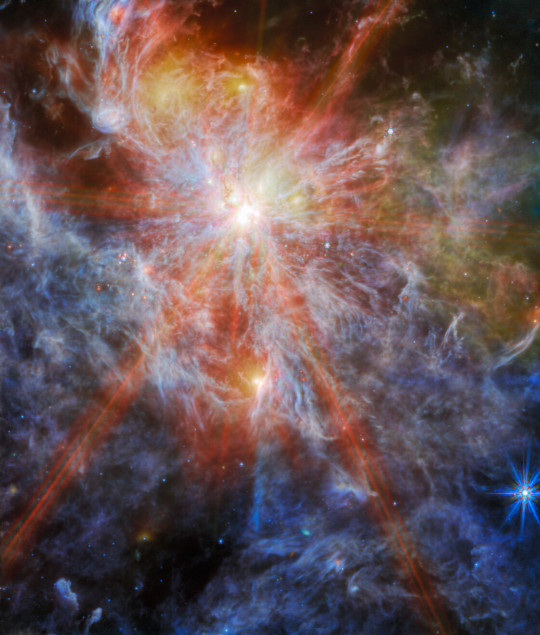
This image from the NASA/ESA/CSA James Webb Space Telescope features an H II region in the Large Magellanic Cloud (LMC), a satellite galaxy of our Milky Way. This nebula, known as N79, is a region of interstellar atomic hydrogen that is ionised, captured here by Webb’s Mid-InfraRed Instrument (MIRI).
#space#james webb space telescope#jwst#science#astronomy#nebula#large magellanic cloud#astrophysics#my post#nasa#esa
53 notes
·
View notes
Text

The Tarantula Nebula (30 Doradus) in the Large Magellanic Cloud // Anthony Knepp
#astronomy#astrophotography#nebula#emission nebula#star-forming region#tarantula nebula#30 Doradus#NGC 2070#large magellanic cloud#LMC#dorado
108 notes
·
View notes
Photo


Red Alert. Credit: ESO/Christoph Malin
ALMA antennae bathed in red light. In the background are the southern Milky Way on the left and the Magellanic Clouds at the top.
#christoph malin#eso#european southern observatory#space#photography#astrophotography#landscape#technology#alma#antennae#astronomy#night#sky#stars#galaxies#night sky#skyporn#large magellanic cloud#small magellanic cloud#lmc#smc#atacama large millimeter/submillimeter array#2013#nature#aesthetic#scienc#detail
45 notes
·
View notes
Text
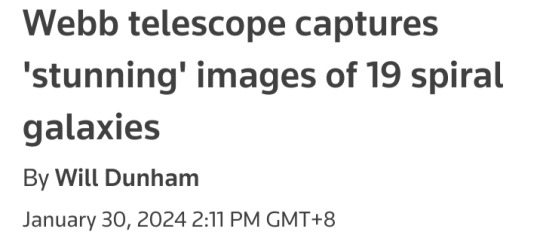
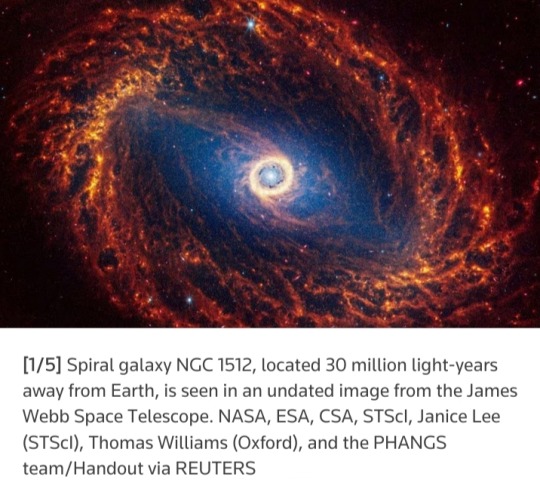
WASHINGTON, Jan 29 (Reuters) — A batch of newly released images captured by the James Webb Space Telescope show in remarkable detail 19 spiral galaxies residing relatively near our Milky Way, offering new clues on star formation as well as galactic structure and evolution.
The images were made public on Monday by a team of scientists involved in a project called Physics at High Angular resolution in Nearby GalaxieS (PHANGS) that operates across several major astronomical observatories.
The closest of the 19 galaxies is called NGC5068, about 15 million light years from Earth, and the most distant of them is NGC1365, about 60 million light years from Earth.
A light year is the distance light travels in a year, 5.9 trillion miles (9.5 trillion km).
The James Webb Space Telescope (JWST) was launched in 2021 and began collecting data in 2022, reshaping the understanding of the early universe while taking wondrous pictures of the cosmos.
The orbiting observatory looks at the universe mainly in the infrared.
The Hubble Space Telescope, launched in 1990 and still operational, has examined it primarily at optical and ultraviolet wavelengths.
Spiral galaxies, resembling enormous pinwheels, are a common galaxy type. Our Milky Way is one.
The new observations came from Webb's Near-Infrared Camera (NIRCam) and Mid-Infrared Instrument (MIRI).
They show roughly 100,000 star clusters and millions or perhaps billions of individual stars.
"These data are important as they give us a new view on the earliest phase of star formation," said University of Oxford astronomer Thomas Williams, who led the team's data processing on the images.
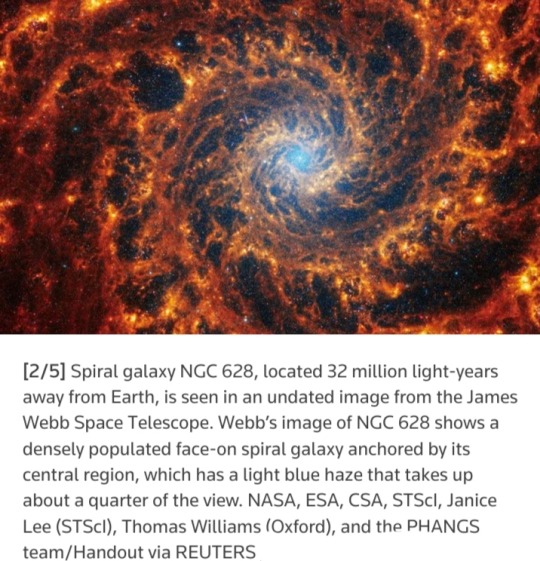
"Stars are born deep within dusty clouds that completely block out the light at visible wavelengths - what the Hubble Space Telescope is sensitive to - but these clouds light up at the JWST wavelengths.
We don't know a lot about this phase, not even really how long it lasts, and so these data will be vital for understanding how stars in galaxies start their lives," Williams added.
About half of spiral galaxies have a straight structure, called a bar, coming out from the galactic center to which the spiral arms are attached.
"The commonly held thought is that galaxies form from the inside-out, and so get bigger and bigger over their lifetimes.
The spiral arms act to sweep up the gas that will form into stars, and the bars act to funnel that same gas in towards the central black hole of the galaxy," Williams said.
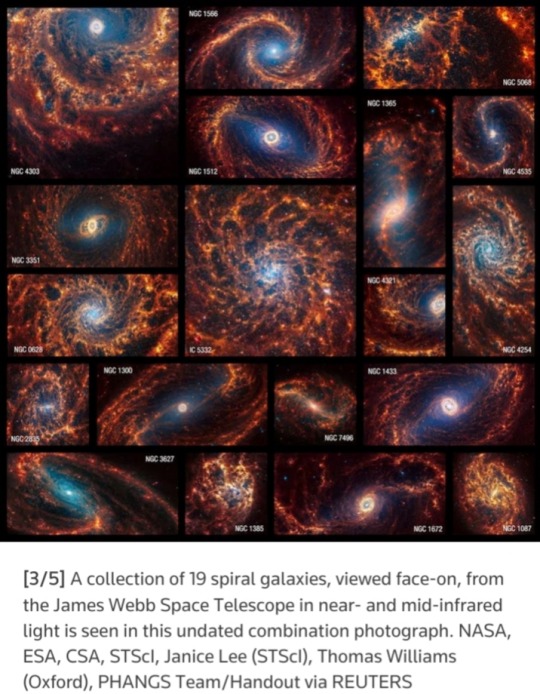
The images let scientists for the first time resolve the structure of the clouds of dust and gas from which stars and planets form at a high level of detail in galaxies beyond the Large Magellanic Cloud and Small Magellanic Cloud, two galaxies considered galactic satellites of the sprawling Milky Way.
"The images are not only aesthetically stunning, they also tell a story about the cycle of star formation and feedback, which is the energy and momentum released by young stars into the space between stars," said astronomer Janice Lee of the Space Telescope Science Institute in Baltimore, principal investigator for the new data.
"It actually looks like there was explosive activity and clearing of the dust and gas on both cluster and kiloparsec (roughly 3,000 light years) scales.
The dynamic process of the overall star formation cycle becomes obvious and qualitatively accessible, even for the public, which makes the images compelling on many different levels," Lee added.
Webb's observations build on Hubble's.
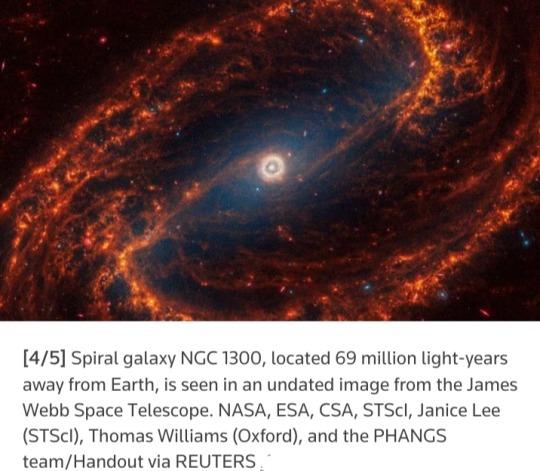
"Using Hubble, we would see the starlight from galaxies, but some of the light was blocked by the dust of galaxies," University of Alberta astronomer Erik Rosolowsky said.
"This limitation made it hard to understand parts of how a galaxy operates as a system. With Webb's view in the infrared, we can see through this dust to see stars behind and within the enshrouding dust."
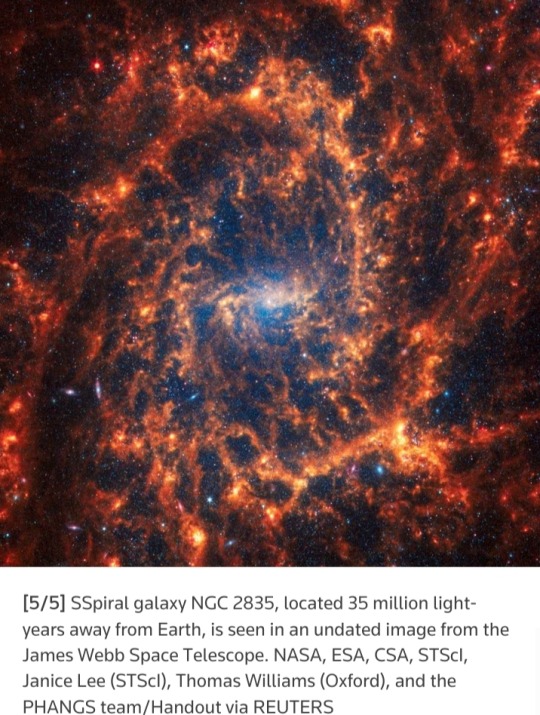
#James Webb Space Telescope#spiral galaxies#Milky Way#Physics at High Angular resolution in Nearby GalaxieS (PHANGS)#NGC5068#NGC1365#light year#Hubble Space Telescope#Near-Infrared Camera (NIRCam)#Mid-Infrared Instrument (MIRI)#astronomy#space#universe#cosmos#Large Magellanic Cloud#Small Magellanic Cloud#Space Telescope Science Institute
37 notes
·
View notes
Text
Magellany (Redo) (Nebulite)
Move out of the way, here comes the greatest adventurer in the whole damn galaxy: Magellany!
"Just call me Mag!"
She is brave, strong and... acts before thinking. She gets irritated easily, especially when people get in her way, calling them get-in-the-ways. Magellany is very rude and honest, never holding back on any comments.
She is a Nebulite, a peculiar species of sentient nebulae. Her body composition makes it possible to morph into any form as she wishes. She is not confined to a humanoid body. Her preferred weapon is her trusty Scimistar.
This magical sword is a projection of her soul which is located on her chest, in the shape of a crystal. Her power comes from this object and is also her weak point.
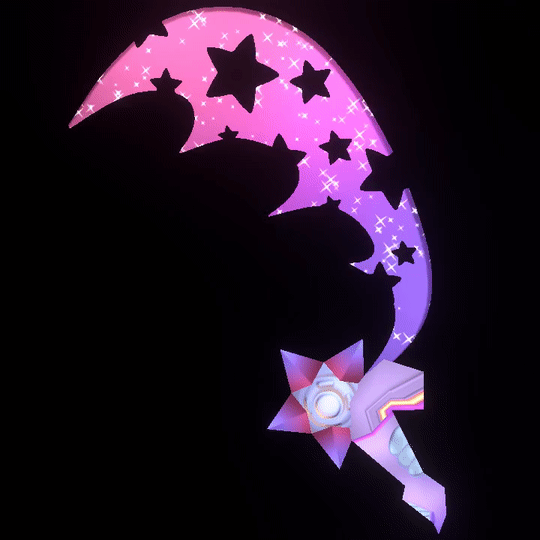
Nebulites have incredible capabilities for Cosmic Magic. While not on the same level as someone like Mr. Sky, they are capable of creating spontaneous life. They do so to help with tasks or do jobs that might be dangerous for them. These rudimentary organisms can last as long as the user needs them to. Their intelligence is very limited though.
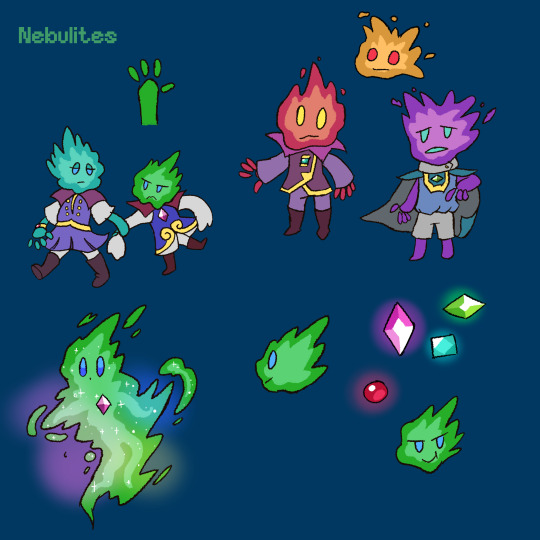
Nebulites. Mag and her older sister depicted here
She is not good with this ability though since nobody taught her and so the most she can do is use raw life energy to create primitive beings that she uses as weapons.
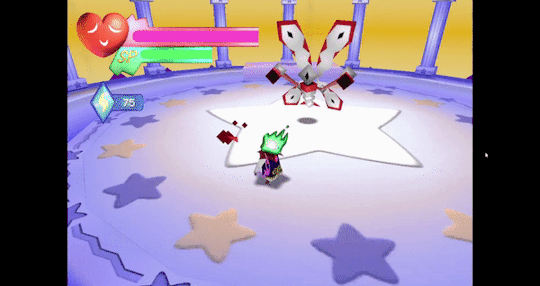
In Soul Trail, her special attack is making a little dude that goes in a straight line and damages far away opponents. Once I restart development I plan on adding more of this ability to her move set.
She claims to hear voices from space. Her favorite animals are tarantulas and she really likes long sleeved clothing along with robes.

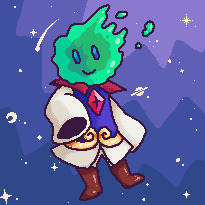

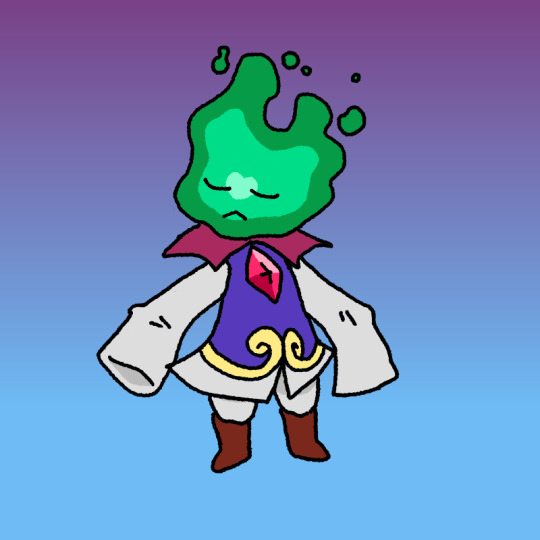
Random works of her made over the years
Backstory
She lives in a solitary planet with her older sister, Nube. Their parents are long gone and so her sister takes care of her and usually does what is best for her. Mag attends navigation classes at some kind of academy and she hates it there. Often daydreaming of what could be is she were able to sail out into space on a ship of her own with treasures to find, foes to defeat, and people to befriend. All in her own way without anyone telling her what to do.
Beneath all her harshness hides a lonely girl who only wants friends and a life she can have control over. Her short-lived creations are the only creatures who stay by her side.

Her creations only live for minutes. She likes to sit on the roof of her house and talk to them
One day something really big would happen that would change her whole life...
Inspiration
As mentioned in the post, she is a nebula; a space cloud. She is meant to be the Magellanic Cloud (hence her name) and her coloration is taken from NGC 2074. The powers Nebulites have of creating life is a reference to how all planets are born from nebulae, this could eventually lead to the creation of life within these planets.
She was the first character made for this project and has gone through some changes over the years.
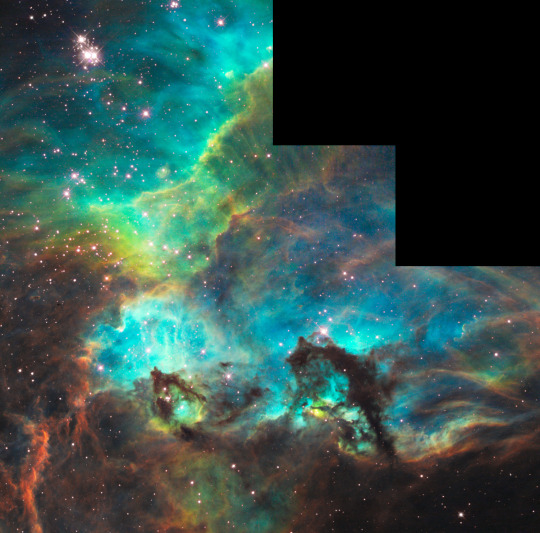
NGC 2074. Fun fact, this photo was taken in my birthday! (Photo credit to NASA)
As for her clothes and design, I was really into Kirby at the time and so many of my early designs sort of looked like spacey Kirby-ish inspired creatures.
This was a much needed redo of my first post on Tumblr.

Her very first drawing. Made in 2019. She used to have a sort of visible skull.

Mildly annoyed. Drawn by @blaz-art
Addendum
It just came to me her outfit was totally inspired by Toon Link from The Legend of Zelda along with her proportions and body shape. Idk why I forgot lol.
Pretty busy at the moment still btw, but still making stuff.

#3d modeling#blender#original character#digital art#art#original oc#gamedev#space#soul trail#ambystoman#lowpoly#nebula#large magellanic cloud#small magellanic cloud
18 notes
·
View notes